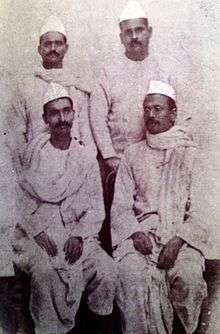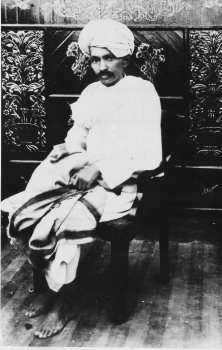Champaran and Kheda Satyagraha

The first Satyagraha movements inspired by Mahatma Gandhi occurred in Champaran district of Bihar and the Kheda district of Gujarat on 1917 to 1918. Champaran Satyagraha was the first to be started, but the word Satyagraha was used for the first time in Anti Rowlatt Act agitation.
Champaran, is a district in the state of Bihar, tens of thousands of landless serfs, indentured labourers and poor farmers were forced to grow indigo (poppy/opium) and similar cash crops by the British East India company and subsequently, the British government in colonized India. The farmers and labourers were forced to grow indigo instead of food crops which were necessary for their survival. This indigo was bought from them at a very low price to export to China as opium.[1]
Suppressed by the ruthless militias of the landlords (mostly British), they were given measly compensation, leaving them in extreme poverty. Now in the throes of a devastating famine, the British levied a harsh tax which they insisted on increasing the rate. Without food and without money, the situation was growing progressively unlivable and the peasants in Champaran revolted against conditions in indigo plant cultivation in 1914 (at Pipra) and in 1916 at (Turkaulia). Raj Kumar Shukla, an indigo cultivator, persuaded Mahatma Gandhi to go to Champaran and thus, the Champaran Satyagraha began. Gandhi ji arrived in Champaran 10 April 1917 with a team of[2] eminent lawyers:[3] Brajkishore Prasad, Rajendra Prasad, Anugrah Narayan Sinha [4] and others including Acharya Kripalani.[5]
Gandhiji's solution
While many civic groups sent petitions and published editorials, Gandhi proposed satyagraha - non-violence, mass civil disobedience. Gandhi also insisted that neither the protestors in Bihar nor in Gujarat allude to or try to propagate the concept of Swaraj (freedom)or Independence. This was not about political independence, but a revolt against harsh conditions amidst a humanitarian disaster. While accepting participants and help from other parts of India, Gandhi insisted that no other district or province revolt against the Government, and that the Indian National Congress not get involved apart from issuing resolutions of support, to prevent the British from giving it cause to use extensive suppressive measures and brand the revolts as treason.
In Champaran
Gandhi established an ashram in Champaran (Bihar), organising scores of his veteran supporters and fresh volunteers from the region. His handpicked team of eminent lawyers comprising [6] Dr.Rajendra Prasad, Dr. Anugrah Narayan Sinha & Babu Brajkishore Prasad organised a detailed study and survey of the villages, accounting the atrocities and terrible episodes of suffering, including the general state of degenerate living.
Building on the confidence of villagers, he began leading the clean-up of villages, building of schools and hospitals and encouraging the village leadership to undo purdah, untouchability and the suppression of women. He was joined by many young nationalists from all over India, including Brajkishore Prasad, Rajendra Prasad, Anugrah Narayan Sinha, Acharya Kriplani,Ram Navami Prasad and later Jawaharlal Nehru.
But his main assault came as he was arrested by police on the charge of creating unrest and was ordered to leave the province. Hundreds of thousands of people protested and rallied outside the jail, police stations and courts demanding his release, which the court unwillingly did. Gandhi led organised protests and strike against the landlords, who with the guidance of the British government, signed an agreement granting more compensation and control over farming for the poor farmers of the region, and cancellation of revenue hikes and collection until the famine ended. It was during this agitation, that Gandhi was addressed by the people as Bapu (Father) and Mahatma (Great Soul).
In Kheda

In Gujarat, Gandhi was chiefly the spiritual head of the struggle. His chief lieutenant, Sardar Vallabhbhai Patel and a close coterie of devoted Gandhians, namely Narhari Parikh, Mohanlal Pandya and Ravi Shankar Vyas toured the countryside, organised the villagers and gave them political leadership and direction. Many aroused Gujaratis from the cities of Ahmedabad and Vadodara joined the organizers of the revolt, but Gandhi and Patel resisted the involvement of Indians from other provinces, seeking to keep it a purely Gujarati struggle.
Patel and his colleagues organised a major tax revolt, and all the different ethnic and caste communities of Kheda rallied around it. The peasants of Kheda signed a petition calling for the tax for this year to be scrapped in wake of the famine. The government in Bombay rejected the charter. They warned that if the peasants did not pay, the lands and property would be confiscated and many arrested. And once confiscated, they would not be returned even if most complied. None of the villages flinched.
The tax withheld, the government's collectors and inspectors sent in thugs to seize property and cattle, while the police forfeited the lands and all agrarian property. The farmers did not resist arrest, nor retaliate to the force employed with violence. Instead, they used their cash and valuables to donate to the Gujarat Sabha which was officially organising the protest.
The revolt was astounding in terms of discipline and unity. Even when all their personal property, land and livelihood were seized, a vast majority of Kheda's farmers remained firmly united in the support of Patel. Gujaratis sympathetic to the revolt in other parts resisted the government machinery, and helped to shelter the relatives and property of the protesting peasants. Those Indians who sought to buy the confiscated lands were ostracised from society. Although nationalists like Sardul Singh Caveeshar called for sympathetic revolts in other parts, Gandhi and Patel firmly rejected the idea.
The Government finally sought to foster an honourable agreement for both parties. The tax for the year in question, and the next would be suspended, and the increase in rate reduced, while all confiscated property would be returned.
People also worked in cohesion to return the confiscated lands to their rightful owners. The ones who had bought the lands seized were influenced to return them, even though the British had officially said it would stand by the buyers.
See also
- Non-co-operation movement
- Indian Independence Movement, Indian Nationalism
- My Autobiography, Or The Story Of My Experiments With Truth (1929) by M.K. Gandhi
- Mahatma Gandhi, Gandhism, Satyagraha, Sardar Vallabhbhai Patel
References
- ↑ Gandhi, M.K. (1925). My experiments with truth. Navajivan Press.
- ↑ aicc. "SATYAGRAHA MOVEMENT OF MAHATMA GANDHI". aicc. Archived from the original on 6 December 2006. Retrieved 8 December 2006.
- ↑ aicc. "SATYAGRAHA MOVEMENT". aicc. Archived from the original on 25 June 2008. Retrieved 8 July 2008.
- ↑ http://www.tribuneindia.com/mobi/news/nation/work-on-to-revive-gandhian-thought/220671.html
- ↑ Brown, Judith Margaret (1972). Gandhi's Rise to Power, Indian Politics 1915-1922: Indian Politics 1915-1922. New Delhi: Cambridge University Press Archive. p. 384. ISBN 978-0-521-09873-1.
- ↑ https://books.google.co.in/books?id=PJeKBAAAQBAJ&pg=PA158&dq=champaran+anugrah+narayan&hl=hi&sa=X&ved=0ahUKEwjxpYKr7MbKAhUDxI4KHe8IDyoQ6AEIITAB#v=onepage&q=champaran%20anugrah%20narayan&f=false
External links
Further reading
- Gandhi's first step: Champaran movement, by Shankar Dayal Singh. B.R. Pub. Corp., 1994. ISBN 81-7018-834-2.
- Peasant Nationalists of Gujarat : Kheda District, 1917-1934 by David Hardiman
- Patel: A Life by Rajmohan Gandhi
- See Day to Day with Gandhi (volume 1), some original documents about the Kheda Satyagraha.
- Satyagraha in Champaran